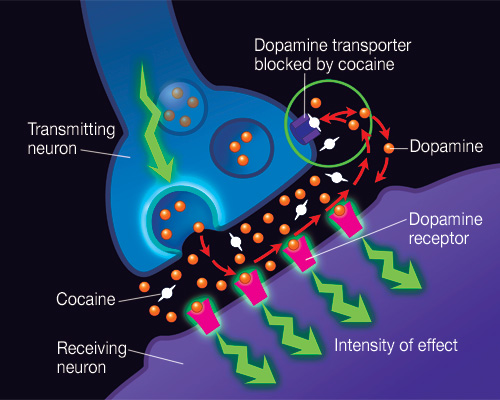
Brief Description:
Cocaine is a powerfully addictive central nervous system stimulant that is snorted, injected, or smoked. Crack is cocaine hydrochloride powder that has been processed to form a rock crystal that is then usually smoked.
Street Names:
Coke, snow, flake, blow. More at Street Terms (Office of National Drug Control Policy Web Site)
Effects:
Cocaine usually makes the user feel euphoric and energetic, but also increases body temperature, blood pressure, and heart rate. Users risk heart attacks, respiratory failure, strokes, seizures, abdominal pain, and nausea. In rare cases, sudden death can occur on the first use of cocaine or unexpectedly afterwards.
Statistics and Trends:
In 2008, 5.3 million Americans age 12 and older had abused cocaine in any form and 1.1 million had abused crack at least once in the year prior to being surveyed. Source: National Survey on Drug Use and Health (Substance Abuse and Mental Health Administration Web Site). The NIDA-funded 2008 Monitoring the Future Study showed that 1.8% of 8th graders, 3.0% of 10th graders, and 4.4% of 12th graders had abused cocaine in any form and 1.1% of 8th graders, 1.3% of 10th graders, and 1.6% of 12th graders had abused crack at least once in the year prior to being surveyed. Source: Monitoring the Future (University of Michigan Web Site) .
How Is Cocaine Abused?



The principal routes of cocaine administration are oral, intranasal, intravenous, and inhalation. Snorting, or intranasal administration, is the process of inhaling cocaine powder through the nostrils, where it is absorbed into the bloodstream through the nasal tissues. The drug also can be rubbed onto mucous tissues. Injecting, or intravenous use, releases the drug directly into the bloodstream and heightens the intensity of its effects. Smoking involves inhaling cocaine vapor or smoke into the lungs, where absorption into the bloodstream is as rapid as by injection. This rather immediate and euphoric effect is one of the reasons that crack became enormously popular in the mid-1980s. Cocaine use ranges from occasional to repeated or compulsive use, with a variety of patterns between these extremes. Other than medical uses, there is no safe way to use cocaine. Any route of administration can lead to absorption of toxic amounts of cocaine, possible acute cardiovascular or cerebrovascular emergencies, and seizures—all of which can result in sudden death.
How Does Cocaine Produce Its Effects?
Research has led to a clear understanding of how cocaine produces its pleasurable effects and why it is so addictive. Scientists have discovered regions within the brain that are stimulated by all types of reinforcing stimuli such as food, sex, and many drugs of abuse. One neural system that appears to be most affected by cocaine originates in a region of the midbrain called the ventral tegmental area (VTA). Nerve fibers originating in the VTA extend to a region known as the nucleus accumbens, one of the brain’s key areas involved in reward. Animal studies show that rewards increase levels of the brain chemical (or neurotransmitter) dopamine, thereby increasing neural activity in the nucleus accumbens. In the normal communication process, dopamine is released by a neuron into the synapse (the small gap between two neurons), where it binds to specialized proteins (called dopamine receptors) on the neighboring neuron and sends a signal to that neuron. Dopamine is then removed from the synapse to be recycled for further use. Drugs of abuse can interfere with this normal communication process. For example, scientists have discovered that cocaine acts by blocking the removal of dopamine from the synapse, which results in an accumulation of dopamine and an amplified signal to the receiving neurons (see image “Cocaine in the brain”). This is what causes the initial euphoria commonly reported by cocaine abusers.

Cocaine in the brain
In the normal communication process, dopamine is released by a neuron into the synapse, where it can bind to dopamine receptors on neighboring neurons. Normally, dopamine is then recycled back into the transmitting neuron by a specialized protein called the dopamine transporter. If cocaine is present, it attaches to the dopamine transporter and blocks the normal recycling process, resulting in a buildup of dopamine in the synapse, which contributes to the pleasurable effects of cocaine.
What Are the Short-Term Effects of Cocaine Use?
Cocaine’s effects appear almost immediately after a single dose and disappear within a few minutes or within an hour. Taken in small amounts, cocaine usually makes the user feel euphoric, energetic, talkative, and mentally alert, especially to the sensations of sight, sound, and touch. It can also temporarily decrease the need for food and sleep. Some users find that the drug helps them perform simple physical and intellectual tasks more quickly, although others experience the opposite effect.
The duration of cocaine’s euphoric effect depends upon the route of administration. The faster the drug is absorbed, the more intense the resulting high, but also the shorter the duration. The high from snorting is relatively slow to arrive but may last 15 to 30 minutes; in contrast, the effects from smoking are more immediate but may last only 5 to 10 minutes.
The short-term physiological effects of cocaine include constricted blood vessels; dilated pupils; and increased temperature, heart rate, and blood pressure. Large amounts of cocaine may intensify the user’s high but can also lead to bizarre, erratic, and violent behavior. Some cocaine users report feelings of restlessness, irritability, and anxiousness. Users may also experience tremors, vertigo, muscle twitches, or paranoia. There can also be severe medical complications associated with cocaine abuse. Some of the most frequent are cardiovascular effects, including disturbances in heart rhythm and heart attacks; neurological effects, including strokes, seizures, headaches, and even coma; and gastrointestinal complications, including abdominal pain and nausea. In rare instances, sudden death can occur on the first use of cocaine or unexpectedly thereafter. Cocaine-related deaths are often a result of cardiac arrest or seizures followed by respiratory arrest.
Research has also revealed a potentially dangerous interaction between cocaine and alcohol. In fact, this mixture is the most common two-drug combination that results in drug-related death.
What Are the Long-Term Effects of Cocaine Use?

Brain images showing decreased dopamine (D2) receptors in the brain of a person addicted to cocaine versus a non-drug user. The dopamine system is important for conditioning and motivation, and alterations such as this are likely responsible, in part, for the diminished sensitivity to natural rewards that develops with addiction.
Cocaine is a powerfully addictive drug. Thus, it is unlikely that an individual will be able to reliably predict or control the extent to which he or she will continue to want or use the drug. And, if addiction takes hold, the risk for relapse is high even following long periods of abstinence. Recent studies have shown that during periods of abstinence, the memory of the cocaine experience or exposure to cues associated with drug use can trigger tremendous craving and relapse to drug use.
With repeated exposure to cocaine, the brain starts to adapt, and the reward pathway becomes less sensitive to natural reinforcers and to the drug itself. Tolerance may develop — this means that higher doses and/or more frequent use of cocaine is needed to register the same level of pleasure experienced during initial use. At the same time, users can also become more sensitive (sensitization) to cocaine’s anxiety-producing, convulsant, and other toxic effects.
Users take cocaine in “binges,” during which the cocaine is used repeatedly and at increasingly higher doses. This can lead to increased irritability, restlessness, and paranoia — even a full-blown paranoid psychosis, in which the individual loses touch with reality and experiences auditory hallucinations. With increasing dosages or frequency of use, the risk of adverse psychological or physiological effects increases.
Different routes of cocaine administration can produce different adverse effects. Regularly snorting cocaine, for example, can lead to loss of sense of smell; nosebleeds; problems with swallowing; hoarseness; and an overall irritation of the nasal septum, which could result in a chronically inflamed, runny nose. Ingested cocaine can cause severe bowel gangrene, due to reduced blood flow. Persons who inject cocaine have puncture marks called “tracks,” most commonly in their forearms, and may experience allergic reactions, either to the drug or to some additive in street cocaine, which in severe cases can result in death. Many chronic cocaine users lose their appetite and experience significant weight loss and malnourishment.
Source: The National Institute on Drug Abuse (NIDA)
Learn How to Spot Signs of Cocaine Use at eHow
© 2018. Pathway to Recovery.
